Coeur d'Alene, Idaho
Coeur d'Alene (/ˌkɔːr dəˈleɪn/ (![]()
Coeur d'Alene | |
|---|---|
| City of Coeur d'Alene | |
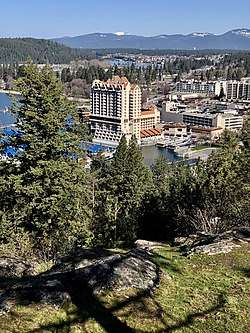 Coeur d'Alene from Tubbs Hill | |
| Nickname(s): Lake City; CDA | |
| Motto(s): City with a Heart[1] | |
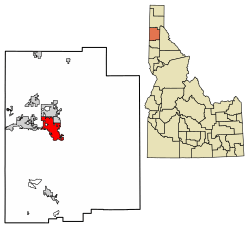 Location of Coeur d'Alene in Kootenai County, Idaho | |
| Coordinates: 47°41′34″N 116°46′48″W | |
| Country | United States |
| State | Idaho |
| County | Kootenai |
| Founded | 1878 |
| Incorporated | August 22, 1887 |
| Government | |
| • Mayor | Steven Widmyer |
| Area | |
| • City | 16.82 sq mi (43.56 km2) |
| • Land | 16.06 sq mi (41.58 km2) |
| • Water | 0.76 sq mi (1.98 km2) |
| Elevation | 2,188 ft (667 m) |
| Population | |
| • City | 44,137 |
| • Estimate (2019)[4] | 52,414 |
| • Density | 3,264.45/sq mi (1,260.41/km2) |
| • Urban | 98,378 |
| • Metro | 144,265 (US: 283rd) |
| • CSA | 679,989 (US: 69th) |
| Time zone | UTC−8 (Pacific) |
| • Summer (DST) | UTC−7 (Pacific) |
| ZIP code | 83814, 83815 |
| Area code(s) | 208 |
| FIPS code | 16-16750 |
| GNIS feature ID | 0379485 |
| Website | www |
The city is named after the Coeur d'Alene People, a federally recognized tribe of Native Americans who lived along the rivers and lakes of the region, in a territory of 5,500 square miles (14,000 km2) extending into Washington and Montana.[11] The origins of the city began with being a fort town; General William Tecumseh Sherman sited what became known as Fort Sherman on the north shore of Lake Coeur d'Alene in 1878. Peopling of the town came when miners and prospectors came to the region after gold and silver deposits were found in the Coeur d'Alene mountains and the Northern Pacific Railroad reached the town in 1883. Rapid growth that led to its eventual incorporation on September 4, 1906 came with workers in the logging industry from 1900 to 1915. After the Great Depression, tourism started to become a major source of development in the area.
The city of Coeur d'Alene has grown significantly in recent years, in part because of a substantial increase in tourism, encouraged by several resorts in the area. The Coeur d'Alene Resort and a 165-acre (0.67 km2) natural area called Tubbs Hill take up a prominent portion of the city's downtown. The city has become known for having one of the largest Holiday Light Shows in the US and hosting a popular Ironman Triathlon event.
Within a short distance, there are several ski resorts and other recreation areas nearby, including Silver Mountain Resort to the east in Kellogg, Lookout Pass Ski and Recreation Area also to the east on Lookout Pass at the Montana border, and Schweitzer Mountain Ski Resort to the north in Sandpoint. The largest theme and water park in the Northwest, Silverwood Theme Park, is located approximately twenty miles (30 km) north and the Coeur d'Alene Casino is located approximately 27 miles south.
History
.jpg)
The Coeur d'Alene people called themselves by the autonym Schitsu'umsh in Coeur d'Alene, one of the Salishan languages, meaning "those who are found here" or "the found ones".[12]
The area was extensively explored by David Thompson of the North West Company starting in 1809 when he established the Kullyspell House on Lake Pend Orielle. Thompson, who usually used native names to describe the places and people he came across for unexplained reasons ascribed the name of “Pointed Hearts” to one the tribes he traded with and “Pointed Heart Lake” for the lake they lived near.[12] As French was the spoken language of the Canadian fur traders, it is likely that “pointed heart” has its origins in the French transliteration of Cœur or “heart”, d’ or “in the middle of” and Alêne or “awl” meaning the tribal traders had hearts as sharp as the tip of an awl or sharp hearted and were shrewd, tough businessmen.[12][11]
The Oregon boundary dispute (or Oregon question) arose as a result of competing British and American claims to the Pacific Northwest of North America in the first half of the 19th century. The British had trading ties extending from Canada and had started settlements in present-day British Columbia and at Fort Astoria on the Pacific coast near the mouth of the Columbia River. The Oregon Treaty of 1846 ended the disputed joint occupation of the area in present-day Idaho when Britain ceded all rights to land south of the 49th parallel to the United States.
With the discovery of gold out west and the establishment of Idaho Territory in 1863, there was an increase in settlers to the region. When General William Tecumseh Sherman was commander of the U.S. Army during the Indian Wars and following the defeat of General George Armstrong Custer at the Battle of Little Big Horn, he erected several forts in the west.[13] During a tour of the Inland Northwest on his way to Fort Walla Walla on the Mullan Road, he was impressed by the scenery of the area and ordered a fort constructed on the lake in 1877 and gave it the name Fort Coeur d'Alene but it was later changed to Fort Sherman to honor the general.[13] The fort, which was established in 1878 is now the site of North Idaho College, which now occupies the former fort site which gave the city its name.
.jpg)
Miners and prospectors came to the region after gold and silver deposits were found in the Coeur d'Alene mountains and the Northern Pacific Railroad came to town in 1883.[14] The town became the location where ore from the mining district was transferred to the rail lines from steamboats that traveled down from the Coeur d'Alene River from the Cataldo Mission.[15] The township was officially incorporated by petition on August 22, 1887.[16] In the 1890s, two significant miners' uprisings took place in the Coeur d'Alene Mining District, where the workers struggled with high risk and low pay.[17] In 1892, the union's discovery of a labor spy in their midst, in the person of Charlie Siringo, sometime cowboy and Pinkerton agent, resulted in a strike that developed into a shooting war between miners and the company. Years later Harry Orchard, who owned a share of the Hercules Mine in the nearby mountains before it began producing, confessed to a secret, brutal and little understood role in the Colorado Labor Wars. He later confessed to dynamiting a $250,000 mill belonging to the Bunker Hill Mining Company near Wardner during another miners' uprising in 1899. He later returned to Idaho to assassinate former Idaho Governor Frank Steunenberg in 1905.[18]
After a U.S. Geologoical Survey done in the 1890s, it became widely known that there were large quantities of white pine, a highly prized softwood, in the Coeur d’Alene Mountains. The lumber industry from the eastern US began to inventory the timberlands, acquire land, and invest in facilities across much of northern Idaho.[19] This was welcome relief to the town of Coeur d’Alene, which had been losing population and reeling from the Panic of 1893, a flood, and the closure of Fort Sherman. Coeur d’Alene incorporated as a city on September 4, 1906, and by 1908 it had become the county seat.[20] The city would experienced significant growth from the timber boom, the development of the railroads and steamboats, and tourism. From 1900 to 1915, there were seventy additions platted and hundreds of homes built.[21] With the advent of the automobile and the internal combustion engine, with trucks and chainsaws, the felling and transporting of trees became more productive and efficient and lumber production reached its height in the late 1910s and 1920s; in 1925 there were seven lumber mills operating in the area and was producing 500 million board feet of lumber.[22]
.jpg)
in the 1930s (or 1940s)
After the 1929 stock market crash and during the Great Depression, the lumber industry demand began to wane and by the mid 1930s about half the woodworkers in northern Idaho were laid off and the surviving mills were producing only 160 million board feet of lumber per year.[23] Although a tough time, the depression years saw the creation of North Idaho College in 1933, Northwest Boulevard through the Works Progress Administration program in 1937 and the building of the popular Playfair Pier on the lake in the early 1940s. Coeur d’Alene benefited from its proximity to the Farragut Naval Training Station established in 1942 on the south end of Lake Pend Oreille, which employed 22,000 people and needed 98 million board feet of lumber to build 650 buildings.[24]
Due to the scenic lake, tourism has always been a factor in the local economy, where it had become popular in Spokane to travel and picnic in the City Park, shop downtown, and take steamboat cruises on the lake and Saint Joe River, it had also received national publicity in magazines where it had been called a “wonderland” and “The Lucerne of America”.[25] However, tourism began to become a mainstay of the economy with the completion of highway infrastructure projects in the 1950s and 60s and the Coeur d’alene Chamber of Commerce began to promote the city as a tourist destination as well.[26] As tourism increased, lodging facilities and demand for other amenities catering to them such as motels, convention space, restaurants, and cultural activities began to increase. By 1976, the city had over 30 motels with about 1,500 rooms.[27] On June 14, 1958 the city hosted the first Diamond Cup Hydroplane race which was one of the largest events in its history and the event garnered national publicity and media coverage.[28] The event attendance was 30,000 people and was considered a success by the Diamond Cup organizers and the race was held at Lake Coeur d’alene for the next eight years until it was eventually discontinued due to persistent difficulties in raising funds for the event.[28]
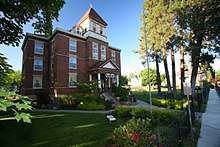
After decades of heavy reliance on logging, in the 1980s, the city featured a more balanced economy with manufacturing, retail and service sectors.[29] Tourism has taken on even more prominence and became one of the main drivers of the local economy since the start of the 1980s, which saw new investment into recreational tourism in the area. In 1982, the city saw the opening of a $2 million Wild Waters aquatic theme park, and spring 1986 saw the opening of the $60 million and 18 story Coeur d’alene Resort.[30] The waterfront resort featured a well manicured frontage and a publicly accessible floating boardwalk gave visitors the impression of a park-like environment and made Coeur d’alene a major tourist destination in the eyes of many as it attracted the attention of publications nationwide.[30][31]
In the 1990s, the Coeur d'Alene area started experiencing a substantial amount of population growth; many of these initial transplants came from California citing earthquakes, crime, and overcrowding as reasons for their move.[32] The state of Idaho has received lots of in-migration and is the fastest growing state in the country. According to Census Bureau data in 2018, the city and county were among the fastest growing metropolitan areas in the nation with a net migration of about 3,200 residents from 2015 to 2016.[33] The sources of the newest transplants are still mainly from western states and are moving for economic as well as political reasons, seeking a lower cost of living, more affordable housing, an outdoor lifestyle and a place that is more conservative.[33]
Geography
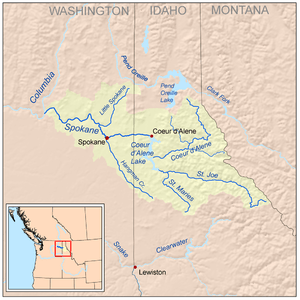
Coeur d'Alene is located at 47°41′34″N 116°46′48″W (47.692845, −116.779910),[34] at an elevation of 2,180 ft (660 m) above sea level. According to the United States Census Bureau, the city has a total area of 16.08 square miles (41.65 km2), of which, 15.57 square miles (40.33 km2) is land and 0.51 square miles (1.32 km2) is water.[35]
Coeur d'Alene is 48 miles (77 km) east of downtown Spokane, Washington, and 416 miles (670 km) east of Seattle.[36] The city is part of the Spokane–Coeur d'Alene metropolitan area and Inland Northwest region, consisting of eastern Washington, north Idaho, northwestern Montana, and northeastern Oregon.[37]
The city located on the north shore of Lake Coeur d'Alene near the outlet of the Spokane River and is in the Northern Rockies ecoregion.[38] Lake Coeur d'Alene is a natural dam-controlled lake that is 25 miles long and one to three miles wide and fed by the Coeur d'Alene and Saint Joe Rivers.[39] Although the Post Falls Dam on the Spokane River near Post Falls controls the lake levels, the lake is usually kept at natural levels from January to June.[40] The Coeur d'Alene Mountains of the Bitterroot Range rise to the east of the city to a maximum elevation of 7,352 feet (2,241 m) at Cherry Peak.[41]
The wooded lands east of the city have been designated for protection and management as the Coeur d'Alene National Forest. The city is surrounded by lakes and forests that support a variety of wildlife. The large lakes in the Idaho panhandle attract birds on the Pacific Flyway and bird watching is popular on Lake Coeur d'Alene, especially from November to February when bald eagles come annually to feed on the spawning kokanee.[42]
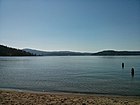
from Tubbs Hill
Climate
Coeur d'Alene has, depending on the definition, a dry-summer continental climate (Köppen Dsb), or a warm-summer Mediterranean climate (Csb), characterized by a cold, moist climate in winter, and very warm, dry conditions in summer.[43][44] It straddles the border between USDA Plant Hardiness Zones 6B and 7A.[45] The monthly daily mean temperature ranges from 29.8 °F (−1.2 °C) in December to 69.0 °F (20.6 °C) in July and August. Temperatures exceed 90 °F (32 °C) on 13 days per year, only occasionally reaching 100 °F (38 °C), while conversely, there may be several nights below 10 °F (−12 °C).[46] Snowfall averages 70 inches (180 cm) per year; precipitation is generally lowest in summer. The average first and last freeze of the season are October 12 and May 3, respectively.
| Climate data for Coeur d'Alene, Idaho (1981−2010 normals) | |||||||||||||
|---|---|---|---|---|---|---|---|---|---|---|---|---|---|
| Month | Jan | Feb | Mar | Apr | May | Jun | Jul | Aug | Sep | Oct | Nov | Dec | Year |
| Record high °F (°C) | 60 (16) |
62 (17) |
73 (23) |
94 (34) |
98 (37) |
104 (40) |
108 (42) |
109 (43) |
102 (39) |
88 (31) |
71 (22) |
60 (16) |
109 (43) |
| Average high °F (°C) | 35.5 (1.9) |
40.2 (4.6) |
49.0 (9.4) |
56.4 (13.6) |
65.2 (18.4) |
72.3 (22.4) |
81.5 (27.5) |
82.5 (28.1) |
72.6 (22.6) |
58.0 (14.4) |
44.0 (6.7) |
34.3 (1.3) |
57.6 (14.2) |
| Daily mean °F (°C) | 30.5 (−0.8) |
33.5 (0.8) |
40.2 (4.6) |
46.6 (8.1) |
54.4 (12.4) |
61.6 (16.4) |
68.9 (20.5) |
69 (21) |
60.1 (15.6) |
48.2 (9.0) |
37.9 (3.3) |
29.8 (−1.2) |
48.4 (9.1) |
| Average low °F (°C) | 25.4 (−3.7) |
26.7 (−2.9) |
31.4 (−0.3) |
36.7 (2.6) |
43.6 (6.4) |
50.9 (10.5) |
56.3 (13.5) |
55.5 (13.1) |
47.6 (8.7) |
38.4 (3.6) |
31.7 (−0.2) |
25.2 (−3.8) |
39.1 (3.9) |
| Record low °F (°C) | −30 (−34) |
−29 (−34) |
−13 (−25) |
5 (−15) |
21 (−6) |
28 (−2) |
36 (2) |
32 (0) |
17 (−8) |
2 (−17) |
−13 (−25) |
−26 (−32) |
−30 (−34) |
| Average precipitation inches (mm) | 3.18 (81) |
2.13 (54) |
2.34 (59) |
1.88 (48) |
2.16 (55) |
1.98 (50) |
0.94 (24) |
0.87 (22) |
1.01 (26) |
1.95 (50) |
3.72 (94) |
3.52 (89) |
25.68 (652) |
| Average snowfall inches (cm) | 10.4 (26) |
4.2 (11) |
1.9 (4.8) |
0.3 (0.76) |
0 (0) |
0 (0) |
0 (0) |
0 (0) |
0 (0) |
0 (0) |
3.9 (9.9) |
11.7 (30) |
32.4 (82.46) |
| Average precipitation days (≥ 0.01 in) | 13.4 | 10.6 | 11.6 | 10.3 | 11.9 | 9.4 | 4.6 | 4.5 | 6.3 | 10.8 | 15.2 | 12.8 | 121.3 |
| Average snowy days (≥ 0.1 in) | 4.8 | 2.7 | 1.1 | 0.2 | 0 | 0 | 0 | 0 | 0 | 0.1 | 2.0 | 5.4 | 16.2 |
| Source: NOAA (extremes 1895−present) [46] | |||||||||||||
Cityscape
Government and politics
The community operates on a Mayor–council government, where the mayor and the six councilors are each elected to four-year terms and the mayor leads the city council meetings that happen on the first and third Tuesday of each month at Coeur d'Alene City Hall.[47][48] The current mayor is Steve Widmyer.[49]
At the state level, The City of Coeur d'Alene is within Idaho Legislative District 2 and Idaho Legislative District 4 for the Idaho House of Representatives and Idaho Senate. At the federal level, Idaho is in Idaho's 1st congressional district and represented by Russ Fulcher in the United States House of Representatives and Mike Crapo and James Risch in the United States Senate.[50][51]
Coeur d'Alene like the state of Idaho as a whole is known for its conservative politics.[52] In local, state, and federal elections, the city and Kootenai County vote reliably conservative and are sometimes noncompetitive and uncontested. This wasn't always the case and some believe that this increasingly rightward trend is among other things a result of demographic shifts in the county that have altered the political landscape of the community and is a part of a general nationwide ideological polarization trend.[53] North Idaho had once been a largely progressive district that was populated by a significant proportion of union laborers that worked the mines in the Silver Valley that had moderated particularly in the 1980s after mine and mill closures and union busting to then have more competitive elections until the late 20th century.[53][54][55][56] Coeur d'Alene is among a small group of cities in the United States that has elected a socialist mayor, electing John T. Wood, a Socialist Party of America member to office in 1911 on a campaign platform of clean water, better health and sanitation standards, and anti-corruption.[57] Since the high growth period beginning in the 1990s, continuing outmigration of conservatives from the west coast states has made elections in the two-party system less competitive over time as the ever newer residents see the city as a place that represents their social and political values, which are sometimes more conservative than the city as a whole.[54][56] Many of the new migrants to the state of Idaho came from California, which accounted for over half the net in-migration between 1992 and 2000 and three of the top four counties that had out-migration to Kootenai County were from southern California–San Diego, Los Angeles, and Orange.[53]
Demographics
| Historical population | |||
|---|---|---|---|
| Census | Pop. | %± | |
| 1890 | 491 | — | |
| 1900 | 508 | 3.5% | |
| 1910 | 7,291 | 1,335.2% | |
| 1920 | 6,447 | −11.6% | |
| 1930 | 8,297 | 28.7% | |
| 1940 | 10,049 | 21.1% | |
| 1950 | 12,198 | 21.4% | |
| 1960 | 14,291 | 17.2% | |
| 1970 | 16,228 | 13.6% | |
| 1980 | 19,913 | 22.7% | |
| 1990 | 24,563 | 23.4% | |
| 2000 | 34,514 | 40.5% | |
| 2010 | 44,137 | 27.9% | |
| Est. 2019 | 52,414 | [4] | 18.8% |
| U.S. Decennial Census[58] | |||
As of the 2010 census[3] of 2010, there were 44,137 people, 18,395 households, and 10,813 families residing in the city. The population density was 2,834.7 inhabitants per square mile (1,094.5/km2). There were 20,219 housing units at an average density of 1,298.6 per square mile (501.4/km2). The racial makeup of the city was 93.8% White, 0.4% African American, 1.2% Native American, 0.8% Asian, 0.1% Pacific Islander, 0.9% from other races, and 2.8% from two or more races. Hispanic or Latino of any race were 4.3% of the population.
There were 18,395 households of which 29.9% had children under the age of 18 living with them, 42.2% were married couples living together, 11.6% had a female householder with no husband present, 5.0% had a male householder with no wife present, and 41.2% were non-families. 31.4% of all households were made up of individuals and 12.1% had someone living alone who was 65 years of age or older. The average household size was 2.33 and the average family size was 2.92.
The median age in the city was 35.4 years. 22.9% of residents were under the age of 18; 11.6% were between the ages of 18 and 24; 26.7% were from 25 to 44; 24% were from 45 to 64; and 14.6% were 65 years of age or older. The gender makeup of the city was 48.6% male and 51.4% female.
Coeur d'Alene has been combined by the Census Burea into the Spokane–Coeur d'Alene combined statistical area (CSA). The CSA comprises the Spokane metropolitan area and the Coeur d'Alene metropolitan area anchored by Coeur d'Alene. The population was 721,928 as of 2017.[59] The principal cities in the CSA are separated by suburbs that largely follow the path of Spokane Valley and Rathdrum Prairie.
According to the Association of Religion Data Archives' 2010 Metro Area Membership Report, the denominational affiliations of the Coeur d’Alene MSA (Kootenai County) are 60,657 Evangelical Protestant, 3,064 Mainline Protestant, 7,597 Catholic, 162 Orthodox, 8,492 Other, and 58,522 Unclaimed.[60] Idaho is part of a region called the Unchurched Belt, a region in the Northwestern United States that has historically low rates of religious participation.
A great deal of the influx of new residents are retirees seeking lower cost of living and traffic; the number of residents aged 65 years and older doubled from 2001 to 2019 according to the Idaho Department of Labor.[61]
An Idaho transplant, Richard Butler, a retired engineer from California came to the Coeur d'Alene area due to its low diversity in 1974 to establish a white supremacist church called the Aryan Nations and began preaching.[62][63] The group went bankrupt and ceased operations in 2000 when the Southern Poverty Law Center filed a lawsuit which ended in a $6.3 million dollar judgement and the closure of their compound.[62] In 1986 Coeur d'Alene was presented the Raoul Wallenberg Award for its stand in countering the neo-Nazis that moved into the area.[64]
Economy
.jpg)
Coeur d'Alene is the healthcare, educational, media, manufacturing, retail and recreation center for north Idaho. After mining and logging declined in the 1940s, tourism came to be the main influence in the local economy ever since. In 2009, Coeur d'Alene ranked No. 12 on Newsmax magazine's list of the "Top 25 Most Uniquely American Cities and Towns," a piece written by current CBS News travel editor Peter Greenberg. In determining his ranking, Greenberg commended the city for "embracing its natural beauty and creating a small-business-friendly environment that has helped develop its thriving tourism industry."[65] Giant statues of bird feathers line Northwest Boulevard, celebrating the rich heritage associated with the Coeur d'Alene Tribe. Art galleries and cafes are along Sherman Avenue, Coeur d'Alene's main street. During summer, artists and musicians frequent Sherman Square. Coeur d'Alene's retail has expanded greatly in recent years with the opening of new stores and entertainment venues. Coeur d'Alene's Village at Riverstone development along Northwest Boulevard houses a park, amphitheater, 14-theater Regal Cinemas, a Hampton Inn, condominiums, restaurants, and local retailers.[66] The North Idaho Centennial Trail, a rail trail cuts through the Riverstone complex northwest of the city center. A Citylink transit center adjoins the northwest entrance of the Riverstone complex.[67]
.jpg)
The city has become a major tourist attraction, being at the heart of north Idaho's scenic Lake Country where water sports and activities like wake boarding, paddleboarding, sailing, parasailing, kayaking, jet skiing, fishing and other lake recreation is popular. In addition to the natural attractions like the Coeur d'Alene City Park and Beach, McEuen Park, and Tubbs Hill, the Coeur d'alene area has two major resorts on the lake, the Coeur d'Alene Resort and the WorldMark Arrow Point resort directly across the lake in Harrison, Idaho, the Coeur d'Alene Casino in Worley, Idaho, and the Pacific Northwest's largest theme park in the Silverwood Theme Park in Athol, Idaho.[68][69][70] There are three major ski resorts in within a short driving distance, Silver Mountain Resort in Kellogg, Lookout Pass Ski and Recreation Area at Lookout Pass near Mullan, and Schweitzer Mountain Ski Resort in Sandpoint. Tourism is the main driver of growth in the community and tourism and hospitality related jobs employed over 10,000 people in north Idaho in 2010.[71]
Companies that have their head offices in Coeur d'Alene include mining company and owner of the Lucky Friday mine in Mullan, Hecla Mining and Canada-based restaurant, Pita Pit (their US operations).[72][73] The knife manufacturer, Buck Knives is the most recognizable brand name in the area, where they relocated the head office and factory from southern California to the Coeur d'Alene suburb of Post Falls, Idaho in 2005.[74] In 2017, the Coeur d'Alene metropolitan area had a gross metropolitan product of $5.93 billion.[75] The Coeur d'Alene metropolitan area has a workforce of 80,000 people and an unemployment rate of 6.8% as of June 2020; the largest sectors for non-farm employment are trade, transportation, and utilities, government, and education and health services as well as leisure and hospitality.[76]
Events and attractions
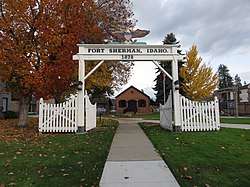
There are many events and activities that can be enjoyed in and around Coeur d’Alene year round but most occur during the warm summer months. Annual community events that the city has big turnouts for include the Fourth of July Festival and the Holiday Light Show that begins at the end of November. Coeur d’Alene has been known for hosting big Fourth of July celebrations since its early days as a fort town. The Fourth of July Festival usually includes a parade down Sherman Avenue, food and craft vendors, carnival rides, and live music and entertainment.[77] Many watch the fireworks by the waterfront and beach; the Coeur d’Alene resort offers fireworks cruises that depart from Independence Point. The Holiday Light Show festivities are kicked off at the end of November and the lights are on display until January 1.[78][79] The event also begins with a parade down Sherman Avenue and ends with a fireworks show. The resort's light show features over 1.5 million bulbs and the resort offers “Journey to the North Pole” cruises; the light show was named in USA Today’s list as one of the best public holiday lights displays in the country in 2019.[80] Another event in the winter months that often gets media attention is the Polar Bear Plunge every year on January 1. Event participants run into the cold waters of Lake Coeur d’Alene at Sanders Beach.[81]
Other popular events include "Car d' Alene," a classic car show which is held annually in June, where car enthusiasts cruise and display their cars.[82] and Art on the Green, which is held on the first weekend in August and hosted by North Idaho Community College.[83] Art on the Green is an arts and crafts outdoor festival sponsored by Citizens' Council for the Arts.
For history enthusiasts, the Museum of North Idaho located in downtown Coeur d'Alene chronicles the history of the region. Permanent exhibits include "Schitsu'umsh, “The People Who Were Discovered Here" which explores the lives of the Coeur d'Alene people, "The Mullan Road" which commemorates Idaho's first road through the Fourth of July Pass, "The Scandinavians Settled Here" which examines the Nordic influences on Coeur d'Alene, and "Steamboats", which displays artifacts and photographs of the steamboats that used to cruise the lake.[84] The museum does walking tours of the Fort Sherman grounds and also rents out the Fort Sherman chapel, the oldest building in the city as a wedding venue.[85][86]
Parks and recreation
The natural environment allows many activities to be enjoyed. The biggest natural attractions and parks in and around the city include Tubb's Hill, City Park and Beach, and McEuen Park all near downtown.
Tubb's Hill is a 120-acre park that is bordered by downtown Coeur d’Alene and McEuen Park to the north and the by lake Coeur d’Alene on the south, east, and west sides.[87] The park features a somewhat rugged 2.2-mile interpretive trail that offers excellent views of the lake and the city. People often cliff jump into the lake from outcroppings in the park. The City Park is occupies 17 acres along the lake near downtown and features is a beach, sand volleyball courts, basketball courts, public drinking and restrooms and shower facilities, picnic tables and a large picnic shelter for events, and a Fort Sherman themed playground for children.[88] McEuen Park, which reopened in 2014 after a remodel, is a 22.5-acre park just north of Tubb's Hill that has a large playground, children's climbing rock, splash pad, two tennis/pickle ball courts, four basketball courts, and an off leash dog park. It also features a large pavilion and grassy amphitheater with concessions and restrooms for hosting large events as well as a boat launch and mooring facilities.[89][90] The popular Kroc Center, a multi-use venue with an aquatics center, a fitness and recreation center as well as educational arts, and wellness programs is located near Ramsey Park just north of the Village at Riverstone.
The North Idaho Centennial Trail and Trail of the Coeur d'Alenes are also popular attractions for outdoor activities. The North Idaho Centennial Trail is a continuation of the 60-mile Spokane River Centennial Trail that runs between Nine Mile Recreation Area in Washington and Wolf Lodge Bay on the north shore of Lake Coeur d'Alene in Idaho.[91] The Trail of the Couer d'Alenes is a 73-mile rail trail that runs between Plummer, Idaho and Mullan, Idaho and passes near Heyburn State Park, Harrison, and Cataldo Mission State Park along the way.[92] Heyburn State Park is the oldest park in the Pacific Northwest and is a popular camping and recreation area in southern Kootenai County along Lake Coeur d'Alene.[93] The Cataldo Mission is a former mission established by the Jesuits and is a national historic landmark that is the site of the oldest building in the state of Idaho.[94] Another popular rail trail in the region and near the terminus of the Trail of the Coeur d'Alenes is the Route of the Hiawatha.[95] Also, to the northeast of the city in the Selkirk Mountains is a popular regional natural area for hiking, Scotchman Peak, where wild mountain goats can be seen.[96]
Sports
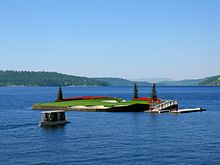
floating green (14th hole)
Coeur d'Alene has become a destination for golf enthusiasts.[97][98] The city is home to five golf courses and there are another eight more within twenty miles.[99] Coeur d'Alene Resort Golf Course is considered one of the best resort courses in the United States.[100] Its 14th hole features the world's only movable floating green.[101][102] There is also the Circling Raven Golf Club at the Coeur d'Alene Casino resort, which has received praise[103] as well as several other private courses nearby, such the Tom Fazio-designed Gozzer Ranch.[104][105]
Coeur d'Alene hosts some sporting events, and the event that receives the most attention is most likely the Ironman Coeur d'Alene. The Ironman Triathlon alternates between full and half distance Ironman events on a rotating basis from year to year.[106] The course takes athletes takes athletes through a 2.4-mile (3.9 km) double-loop swim in Lake Coeur d’Alene before transitioning to a 112-mile (180 km) double-loop bike course that is routed along the lake and then through the countryside and finally ends in a 26.2-mile (42.2 km) multiple-loop run through McEuen Park to a finish in downtown on Sherman Ave.[107] Other less intense and rigorous athletic events in town include the 15–108 mi (24–174 km) Coeur d'Fondo bike race[108] and the Coeur d'Alene Crossing, a 2.4-mile swimming challenge where participants attempt to cross the lake.[109]
Education
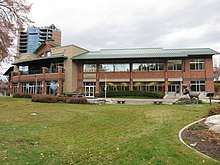
in 2018
Library services for the city of Coeur d’Alene are met by two public libraries, the Coeur d'alene Public Library in downtown and the Lake City Public Library near Lake City High School.[110][111] The Community Library Network maintains seven libraries in the wider communities in Kootenai and Shoshone counties, including branches in Post Falls, Hayden, Rathdrum, Spirit Lake, Athol, and Harrison.[112]
The Coeur d'Alene School District#271 serves around 11,000 students in 18 schools which includes two traditional high schools (Couer d-Alene and Lake City), an alternative high school, three middle schools, eleven elementary schools, and a dropout retrieval school.[113] District #271 students who qualify are also eligible for dual enrollment with North Idaho College and the University of Idaho. Also on offer in the district are magnet schools that focus on specific curricula such as the Sorensen Magnet School of the Arts and Humanities and Ramsey Magnet School of Science elementary schools and the Fernan STEM Academy, offering a STEM focus.[113] The district is the sixth largest in the state and second largest employer in Kootenai County.[114] Coeur d'Alene also has a charter school, the Coeur d'Alene Charter Academy.
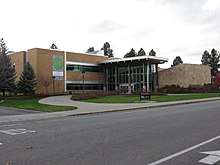
in 2018
Post secondary education is fulfilled by North Idaho College, a public community college founded in 1933 in downtown Coeur d’Alene on the former site of Fort Sherman. The college has an enrollment of about 6,000 students and has outreach branches in Kellogg, Sandpoint, and Bonners Ferry, Idaho.[115] The University of Idaho has a Coeur d’alene presence and has a research park in the area.[116]
Infrastructure
Transportation
Roads and highways
.jpg)
In Coeur d'Alene, the city roads are oriented in the four cardinal directions, with roads going north-south being designated as "streets" and roads going east-west as "avenues". Major east-west thoroughfares include Sherman Avenue and Harrison Avenue and major north-south thoroughfares include U.S. 95, Government Way, 15th Street, and Ramsey Street.[117][118] Coeur d'Alene is accessed from Interstate 90 at Exits 11 through 15;[119] To the east on I-90 is the Fourth of July Pass and Lookout Pass that traverse the Rocky Mountains into Montana near Mullan.[120]
Before the construction of I-90, the city was served by U.S. Route 10, which ran through downtown; this route is now Northwest Boulevard and Sherman Avenue. The former US 10, between I-90 exits 11 and 15, is now designated as Interstate 90 Business. The greater Coeur d'Alene area is almost entirely dependent upon private automobiles for transportation, the city has a Walk Score of 36, indicating most errands require a car.[121] Combined with the city's rapid growth since 1990, relative congestion now occurs on a significant portion of the area highways, notably U.S. 95 between Northwest Blvd. north to Hayden.[122]
Public transportation
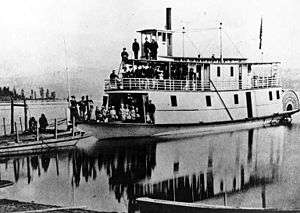
Public transportation played a significant role in Coeur d'Alenes' early growth as a tourist destination. When an interurban electric railroad line was completed in 1903 from Spokane to the city, Inland Northwest residents often flocked to Lake Coeur d'Alene to enjoy being on the lake and going on steamboat cruises and other activities.[123] The interurban electric line would later become the Spokane and Inland Empire Railroad. The steamboats on Lake Coeur d'Alene were not only used to transport goods such as ore and timber, but also people. More steamboats operated on Lake Coeur d’Alene than on any other lake west of the Great Lakes and there were intense rivalries between the steamboat lines.[124] Steam navigation on Lake Coeur d'Alene lasted from the 1880s to the 1930s.
Today, free public bus service is available to area residents, provided by Citylink. Citylink buses operate in the urbanized area of Kootenai County, leaving the Riverstone Transfer Station every sixty minutes, seven days a week, including holidays. Buses are wheelchair-accessible and can transport up to two bicycles.[125]
The bus system comprises four separate routes:[126] Urban Route B which serves Post Falls, Hayden and West Coeur d'Alene, Urban Route C which serves Downtown Coeur d'Alene, Fernan and Hayden, Rural Route, which serves the towns of Worley, Plummer, Tensed, and De Smet; and the Link Route, which connects the two transfer stations at Riverstone and Worley.
Extension of Spokane Transit Authority service into Idaho, mainly an hourly express bus to and from Coeur d'Alene, was originally proposed as part of the 2015 "STA Moving Forward" ballot measure, the ballot measure eventually passed and service is expected to commence in 2025.[127][128]
Airports
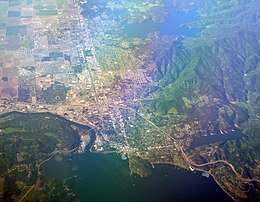
The closest major airport serving Coeur d'Alene and North Idaho is Spokane International Airport, which is served by six airlines and is 40 miles (64 km) to the west in Spokane, Washington.[129]
The Coeur d'Alene Airport – Pappy Boyington Field (KCOE) is a general aviation airport in Hayden, north of the city near U.S. 95. The local airport is a public-use, general aviation airport. In 1941, the Coeur d’Alene Chamber of Commerce promoted the purchase of 720 acres (290 ha) of land on the Rathdrum Prairie for the runway. The facility was built in 1942 by the Army Engineers at a cost of over $400,000. It was designated as an alternate to Weeks Field (now, Kootenai County Fairgrounds) when a war training program was in operation for World War II.
Near the marina on Lake Coeur d'Alene is the Brooks Seaplane Base, which is a city-owned, public-use seaplane base that is used for general aviation and air taxi purposes to conduct tours of Lake Coeur d'Alene and Lake Pend Orielle.[130]
Utilities
.jpg)
The city of Coeur d'Alene provides billing services for municipal water, sewer and stormwater management, street lighting, garbage collection, and recycling; Avista Utilities provides both power and natural gas services in the area.[131] The city draws its water supply from the Spokane Valley–Rathdrum Prairie Aquifer. Telecom services such as television, internet, and telephone service are provided by a variety of vendors including Frontier Communications, Spectrum, Time Warner, and TDS Telecom.[131]
The Post Falls hydroelectric dam on the Spokane River was built in 1906 and has a generation capacity of 14.75 megawatts.[132]
Media
Coeur d'Alene is part of the Spokane, Washington TV and radio media market and receives broadcasts in the Pacific Time Zone. Coeur d'Alene is the city of license for some television and radio stations in the broadcast area such as Idaho Public Television station, KCDT.[133] In print media, Coeur d'Alene is also covered by Spokane's major daily newspaper, The Spokesman–Review, but the city has its own local newspaper, the Coeur d'Alene Press which covers local issues in north Idaho and has an estimated circulation of about 17,300.[134] The publication was founded in 1892 by Joseph T. Scott.[135] The newspaper is among the properties of the Hagadone Corporation which is run by Duane Hagadone.
Healthcare
Kootenai Health is the primary medical center serving the Coeur d'Alene and north Idaho communities. The hospital has 330 beds and is a Level III trauma center.[136][137] With over 3,400 employees, it is the largest employer in Kootenai County.[138]
Notable people
.jpg)
at Higgens Point
- Sherman Alexie, author.
- Leepu Nizamuddin Awlia, automotive designer, originally from Bangladesh, lives and works here
- Rocky Bridges (1927–2015), former MLB baseball player, lived in Coeur d'Alene[139]
- Gregory "Pappy" Boyington, World War II flying ace and USMC colonel, was born in Coeur d'Alene . A Medal of Honor recipient, he was a member of the AVG (Flying Tigers) and later the commander of VMF-214, the famous Black Sheep Squadron.[140] The local airport was named in his honor in 2007.
- Douglas Crimp, art historian, queer theorist, activist.
- Dan Cummins, professional stand-up comedian
- Dorthea Dahl, Norwegian-born American writer, wrote and published her collections of short stories and her novel while residing near Coeur d'Alene
- Adrienne Dore, model and actress
- Patty Duke, Academy Award-winning actress, lived in Coeur d'Alene from the mid-1990s until her death in 2016
- Dennis Franz, actor, resides in Coeur d'Alene
- John Friesz, former NFL quarterback
- Sage Kotsenburg, snowboarder who won the first gold medal at the 2014 Winter Olympics for men's snowboard slopestyle in Sochi, Russia; born in Coeur d'Alene[141]
- Robert Lamphere, FBI agent who helped track down a number of Soviet atomic spies[142]
- Chuck Missler, former CEO of Western Digital
- Brock Osweiler, NFL quarterback
- Trevor Prangley, pro mixed-martial artist with a background in wrestling and a former fighter in the UFC; he was born in South Africa and now resides in Coeur d'Alene
- Rollin Putzier, NFL player
- Bruce Reed, previous CEO of the Democratic Leadership Council (DLC) and previous Chief of Staff to U.S. Vice President Joe Biden
- Luke Ridnour, former NBA point guard[143]
- Marilynne Robinson, Pulitzer-prize winning novelist and essayist
- Burt Rutan, aircraft designer and engineer
- Marshall Savage, author and futurist; has made Coeur d'Alene his home since 1998
- Charles Sellier, television producer and director; his credits included The Life and Times of Grizzly Adams[144][145]
- Robert Titsch, co-founder of the television network C-SPAN
- Evelyn Venable, actress, died in Coeur d'Alene
Sister cities
Coeur d'Alene has one sister city:[146]
.svg.png)
References
- Oliveria, Dave F. (May 24, 2011). "Walla Walla Slogan Among Worst". The Spokesman-Review. Retrieved August 8, 2020.
- "2019 U.S. Gazetteer Files". United States Census Bureau. Retrieved July 9, 2020.
- "U.S. Census website". United States Census Bureau. Retrieved 2012-12-18.
- "Population and Housing Unit Estimates". United States Census Bureau. May 24, 2020. Retrieved May 27, 2020.
- "Coeur d'Alene". The American Heritage Dictionary of the English Language (5th ed.). Boston: Houghton Mifflin Harcourt. Retrieved May 16, 2019.
- "Coeur d'Alene". Oxford Dictionaries US Dictionary. Oxford University Press. Retrieved May 16, 2019.
- "Coeur d'Alene". Merriam-Webster Dictionary. Retrieved May 16, 2019.
- "Find a County". National Association of Counties. Archived from the original on 2011-05-31. Retrieved 2011-06-07.
- "2018 estimate". United States Census Bureau. Retrieved 2019-07-10.
- "Annual Estimates of the Population of Combined Statistical Areas: April 1, 2010 to July 1, 2013". 2013 Population Estimates. United States Census Bureau, Population Division. June 16, 2014. Archived from the original on June 27, 2014. Retrieved June 16, 2014.
- Frey, Rodney. "Coeur d'Alene (Schitsu'umsh)". Retrieved 17 July 2013.
- Singletary p. VII
- Singletary p. 1
- Singletary p. 11
- Singletary p. 13
- Singletary p. 14
- Carlson pp. 53–54
- Carlson pp. 91–92
- Singletary p. 27
- Singletary pp. 36-38
- Singletary p. 49
- Singletary p.79, p. 93
- Singletary p. 93
- Singletary p. 113
- Singletary p. 27, pp. 31-32
- Singletary pp. 137-138
- Singletary p. 141
- Singletary p. 147
- Singletary p. 173
- Singletary p. 176
- Egan, Timothy (September 21, 1986). "NATIONAL NOTEBOOK: Coeur d'Alene, Idaho; Wilderness Luxury". New York Times. Retrieved August 8, 2020.
- Glionna, John M. (August 8, 1994). "Welcome to the Potato State--Now Go Home : Idaho: Californians fleeing big-city problems have been met with resentment by their new neighbors". Los Angeles Times. Retrieved August 8, 2020.
- Criscione, Wilson (January 11, 2018). "In North Idaho, leaders brace for rapid population growth". Inlander. Retrieved August 8, 2020.
- "US Gazetteer files: 2010, 2000, and 1990". United States Census Bureau. 2011-02-12. Retrieved 2011-04-23.
- "US Gazetteer files 2010". United States Census Bureau. Archived from the original on 2012-07-02. Retrieved 2012-12-18.
- "How Far is it Between". Free Map Tools. Retrieved July 29, 2020.
- "Inland Empire". Merriam-Webster, Incorporated. Retrieved July 29, 2020.
- "Draft: Level III and IV Ecoregions of the Northwestern United States". U.S. Environmental Protection Agency. May 15, 2002. Retrieved July 29, 2020.
- Schultz, Jule (August 14, 2018). "Coeur d'Alene Lake: The Good, The Bad, and The Ugly". Spokane Riverkeeper. Retrieved August 12, 2020.
- "Is Coeur d'Alene Lake a Reservoir or Lake?". Avista Corporation. Retrieved August 12, 2020.
- "Cour d'Alene Mountains". Peakbagger.com. Retrieved August 8, 2020.
- "Lake Coeur d'Alene Eagle Watch". Bureau of Land Management. Retrieved August 8, 2020.
- Beck, Hylke E.; Zimmermann, Niklaus E.; McVicar, Tim R.; Vergopolan, Noemi; Berg, Alexis; Wood, Eric F. (30 October 2018). "Present and future Köppen-Geiger climate classification maps at 1-km resolution". Scientific Data. 5: 180214. Bibcode:2018NatSD...580214B. doi:10.1038/sdata.2018.214. ISSN 2052-4463. PMC 6207062. PMID 30375988.
- "Coeur d'Alene Climate". Climate-Data.org. Retrieved August 8, 2020.
- "Coeur d'Alene, Idaho Hardiness Zone Map". PlantMaps. Retrieved August 8, 2020.
- "NowData – NOAA Online Weather Data". National Oceanic and Atmospheric Administration. Retrieved 2012-02-15.
- "City Council". City of Coeur d'Alene. Retrieved August 8, 2020.
- "Council Members". City of Coeur d'Alene. Retrieved August 8, 2020.
- "Mayor Steve Widmyer". City of Coeur d'Alene. Retrieved August 8, 2020.
- "Find Your Representative". U.S. House of Representatives. Retrieved August 8, 2020.
- "Senators of the 116th Congress". www.senate.gov. Retrieved August 8, 2020.
- Blanchard, Nicole (July 26, 2018). "These are the 20 most liberal places in Idaho". Idaho Statesman. Retrieved August 12, 2020.
- Crane-Murdoch, Sierra (May 20, 2013). "How right-wing emigrants conquered North Idaho". 8 (45). High Country News. Retrieved August 8, 2020. Cite journal requires
|journal=(help) - "State of the Re:Union - Coeur d'Alene and Ideology Migration". Spokane Public Radio. Retrieved August 8, 2020.
- Siegler, Kirk (February 14, 2017). "Leaving Urban Areas For The Political Homogeneity Of Rural Towns". Morning Edition. National Public Radio. Retrieved August 14, 2020.
- Petersen, Anne Helen (October 22, 2017). "Here's What Happens When Republicans Have No One To Fight". BuzzFeed News. Retrieved August 14, 2020.
- Singletary p. 63
- "Census of Population and Housing". Census.gov. Retrieved June 4, 2015.
- "Census Reporter: Spokane-Spokane Valley-Coeur d'Alene, WA-ID CSA". United States Census Bureau. Retrieved June 9, 2019.
- "Kootenai County (Idaho)". Metro-Area Membership Report. The Association of Religion Data Archives, Pennsylvania State University. 2010. Retrieved July 28, 2020.
- Nellis, Natasha (April 9, 2020). "North Idaho looks to accommodate influx of retirees". Spokane Journal of Business. Retrieved August 8, 2020.
- Struck, Doug (August 31, 2017). "The Idaho town that stared down hate – and won". Christian Science Monitor. Retrieved August 8, 2020.
- Smith, Joel (October 15, 2009). "Whitopia, Idaho". Inlander. Retrieved July 28, 2020.
- Sam Howe Verhovek. "Public Lives; In a Verdict, a Sign That His Town Is No Haven for Hate". In The New York Times, Sept. 9, 2000.
- Greenberg, Peter. "Newsmax Magazine Rates the Top 25 Most Uniquely American Cities And Towns". Retrieved 15 January 2014.
- "Riverstone". City of Coeur d'Alene. Retrieved August 9, 2020.
- Lind, Treva (March 19, 2017). "The Dirt: Work to start on Citylink bus hub in Kootenai County". The Spokesman-Review. Retrieved August 9, 2020.
- Kramer, Becky (May 3, 2006). "Resort a gamble that's still paying off". The Spokesman-Review. Retrieved July 24, 2020.
- "WorldMark Arrow Point #6366". RCI, LLC. Retrieved July 24, 2020.
- Podplesky, Azaria (May 2, 2018). "Silverwood celebrates 30th anniversary with new additions, $19.88 tickets". The Spokesman-Review. Retrieved July 24, 2020.
- "Idaho Economic Outlook: Coeur d'Alene Tourism Boosts all of Idaho". July 19, 2015. Retrieved July 24, 2020.
- "Hecla Mining Company". Reuters. Retrieved July 24, 2020.
- "The Pita Pit". Dun & Bradstreet. Retrieved July 24, 2020.
- Cole, David (April 23, 2009). "Buck Knives brings work back to U.S." Spokane Journal of Business. Retrieved July 24, 2020.
- "GDP & Personal Income". United States Department of Commerce: Bureau of Economic Analysis. Retrieved January 21, 2019.
- https://www.bls.gov/eag/eag.id_coeurdalene_msa.htm
- Podplesky, Azaria (June 28, 2019). "Bursting with fun: Fourth of July celebrations across the Inland Northwest". The Spokesman-Review. Retrieved August 8, 2020.
- Orcutt, April (November 22, 2019). "Where to see the best holiday lights in the West". Los Angeles Times. Retrieved August 9, 2020.
- "Heading to the Coeur d'Alene Holiday Light Show? Better dress in layers!". KHQ. November 29, 2019. Retrieved August 9, 2020.
- Schrandt, Lydia (November 24, 2014). "Vote for the best public holiday lights display!". USA Today. Retrieved August 9, 2020.
- Glover, Jonathan (January 2, 2019). "Hundreds ring in New Year with icy dip in Lake Coeur d'Alene for Polar Bear Plunge". The Spokesman-Review. Retrieved August 9, 2020.
- "Car D'Lane". Coeur d'Alene Downtown Association. Retrieved August 25, 2017.
- "Art on the Green". Art on the Green at North Idaho College. Retrieved August 9, 2020.
- "Permanent Exhibits". Museum of North Idaho. Retrieved August 9, 2020.
- "Museum of North Idaho". Smithsonian Magazine. Retrieved August 9, 2020.
- "Fort Sherman Chapel". Museum of North Idaho. Retrieved August 9, 2020.
- "Tubbs Hill". City of Coeur d'Alene. Retrieved August 9, 2020.
- "Coeur d'Alene City Park". City of Coeur d'Alene. Retrieved August 9, 2020.
- "McEuen Park". City of Coeur d'Alene. Retrieved August 9, 2020.
- Maben, Scott (April 26, 2014). "Contentious makeover of McEuen Park in CdA set for partial opening". The Spokesman-Review. Retrieved August 9, 2020.
- Thorness, Bill (June 21, 2018). "Want to bike from Spokane to Coeur d'Alene? Take the 2-state, 60-mile Centennial Trail". The Seattle Times. Retrieved August 9, 2020.
- "Trail of the Coeur d'Alenes". TrailLink. Retrieved August 9, 2020.
- "Heyburn State Park". Idaho State Parks. Retrieved August 9, 2020.
- "Coeur d' Alene's Old Mission State Park". Idaho State Parks and Recreation. Retrieved August 9, 2020.
- "Route of the Hiawatha". TrailLink. Retrieved August 9, 2020.
- "Scotchman Peak". Washington Trails Association. Retrieved August 9, 2020.
- Gavrich, Tim (July 8, 2019). "Trip dispatch: Contrasting courses coax golfers to Coeur d'Alene". Golf Advisor. Retrieved August 9, 2020.
- "Coeur d'Alene Golf Guide". GolfTrips.com. Retrieved August 9, 2020.
- "Coeur D Alene, Idaho Golf Courses". GolfLink. Retrieved August 9, 2020.
- "Readers' Choice Rankings: The Top 50 Resort Courses". Golf Digest. September 17, 2009. Retrieved August 9, 2020.
- Flemma, Jay (May 23, 2018). "The Floating Green at Coeur D'Alene – Still a Wonder of the Golf World". The Golf Course Trades. Retrieved August 9, 2020.
- "The Course - Golf - Discover - The Coeur d'Alene Resort". Coeur d'Alene Resort. Retrieved 25 August 2017.
- Shepherd, Dan (August 25, 2009). "Golf Digest Magazine Ranks Circling Raven No. 17 Nationwide Among its 'America's 100 Greatest Public Courses Re-Ranked by Price'". The Golf Wire. Retrieved August 8, 2020.
- "Gozzer Ranch Golf & Lake Club". Golf Digest. January 3, 2019. Retrieved August 8, 2020.
- "Gozzer Ranch Golf & Lake Club". Top100GolfCourses. Retrieved August 8, 2020.
- Collingwood, Ryan (November 21, 2019). "Full Ironman race announces return to Coeur d'Alene in 2021". The Spokesman-Review. Retrieved August 9, 2020.
- Gary (November 22, 2019). "Return of full distance IRONMAN to Coeur d'Alene in 2021". EnduranceBusiness.com. Retrieved August 9, 2020.
- Landers, Rich (July 11, 2017). "2017 Northwest Bicycling Events Calendar". The Spokesman-Review. Retrieved August 9, 2020.
- Hales, Susan (July 15, 2017). "The Coeur d'Alene Crossing (August 13)". Out There Monthly. Retrieved August 9, 2020.
- "Library Hours & Location". Coeur d'Alene Public Library. Retrieved August 9, 2020.
- "Library Hours & Location". Lake City Public Library. Retrieved August 9, 2020.
- "Facilities". Community Library Network. Retrieved August 9, 2020.
- "Coeur d'Alene Public Schools". Coeur d’Alene School District. Retrieved August 9, 2020.
- "District Snapshot". Coeur d’Alene School District. Retrieved August 9, 2020.
- "About NIC". North Idaho College. Retrieved August 9, 2020.
- "U of I Locations: Coeur d'Alene". University of Idaho. Retrieved August 9, 2020.
- "CDA Map". City of Coeur d'Alene. Retrieved August 9, 2020.
- "City Street Map" (PDF). City of Coeur d'Alene. Retrieved August 9, 2020.
- "Idaho Highway Map" (PDF). Idaho Department of Commerce - Tourism Development. Retrieved August 9, 2020.
- "Mountain Passes on I-90". Idaho Transportation Department. Retrieved August 9, 2020.
- "Living in Coeur d'Alene". Walk Score. Retrieved August 9, 2020.
- "Traffic Counts". City of Coeur d'Alene. Retrieved August 9, 2020.
- Singletary pp. 31-32
- Holt pp. 141-155
- "Citylink". Citylink. Retrieved August 9, 2020.
- "Citylink Routes". Citylink. Retrieved August 9, 2020.
- "STA Moving Forward - Post Falls and Coeur d'Alene - High Performance Transit". Spokane Transit Authority. Retrieved 2020-04-21.
- Kelety, Josh (March 5, 2020). "With ridership declining, we hop on the bus with one big question in mind: Where is the STA headed?". Inlander. Retrieved August 13, 2020.
- "About Spokane International Airport". Spokane International Airport. Retrieved August 7, 2020.
- "Brooks Seaplane Base". AirNav. Retrieved August 9, 2020.
- "Business Advantages". cdaedc.org. Retrieved August 9, 2020.
- Drake, Michele M. (November 1, 2008). "Post Falls: Powering Northern Idaho for More than a Century". 27 (7). Hydro Review. Retrieved August 12, 2020. Cite journal requires
|journal=(help) - "TV Station Profile: KCDT". Federal Communications Commission. Retrieved August 9, 2020.
- "Coeur d'Alene Press". Mondo Times. Retrieved August 9, 2020.
- Singletary p. 121
- "Frequently Asked Questions". Kootenai Health. Retrieved August 9, 2020.
- "Trauma Centers". American College of Surgeons. Retrieved August 8, 2020.
- "Mission, Vision and Facts - Kootenai Health". Kh.org. Archived from the original on 2017-03-17. Retrieved 2017-03-17.
- GmbH, StarTiger.com - MicroTide. "Send Fan Mail to Rocky Bridges / Celebrity Address on StarTiger". Startiger.com. Retrieved 25 August 2017.
- "G.H. Boyington", Arlington National Cemetery
- "Archived copy". Archived from the original on 2014-03-02. Retrieved 2014-03-02.CS1 maint: archived copy as title (link)
- Rhodes, Richard. Dark Sun. Simon & Schuster, New York, 1995. pg. 336
- "Luke Ridnour - Toronto - National Basketball Association - Yahoo! Sports". Yahoo Sports. Retrieved 25 August 2017.
- Hevesi, Dennis (2011-02-04). "Charles Sellier Jr., Creator of 'Grizzly Adams,' Dies at 67". The New York Times. Retrieved 2011-02-11.
- Dumas, Michael (2011-02-08). "Charles Sellier Jr., creator of 'Grizzly Adams,' dies at 67". Press-Register. Retrieved 2011-02-11.
- "Sister Cities & States". Idaho.gov. Retrieved August 9, 2020.
Bibliography
- Holt, Ruby El (1951). "Shadowy St. Joe". Steamboats in the Timber (1st ed.). Caldwell, ID: Caxton Printers, Ltd. pp. 141–155. LCCN 52-5206.
- Carlson, Peter (1983). Roughneck: The life and times of Big Bill Haywood. New York; London: W.W. Norton. ISBN 978-0393016215. OCLC 494048851.
- Singletary, Robert (2019). Coeur D'Alene Beautiful and Progressive: An Illustrated History of Coeur D'Alene Idaho 1878-1990. Coeur D'Alene, ID: Museum of North Idaho. ISBN 9780982522097.
Further reading
- State of Idaho (1903). An illustrated history of north Idaho : embracing Nez Perces, Idaho, Latah, Kootenai and Shoshone counties. Spokane, WA: Western Historical Publishing Company. ASIN B009N4P7RU. OCLC 7975082.
External links
| Wikimedia Commons has media related to Coeur d'Alene, Idaho. |

- City of Coeur d'Alene Official Website
- Coeur d'Alene Convention & Visitor Bureau
- "Coeur d'Alene, Idaho". C-SPAN Cities Tour. December 2013.
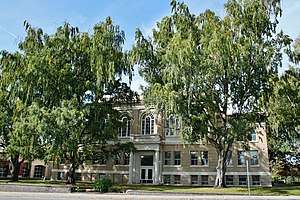
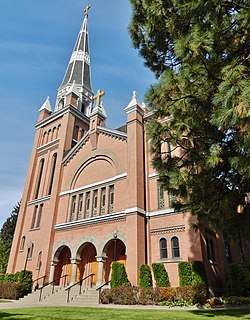
.jpg)
